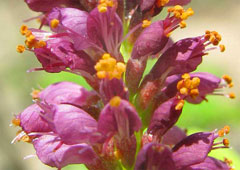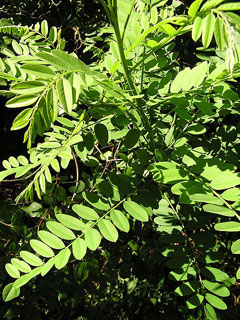 |
|
http://commons.wikimedia.org/wiki/User:Gromhelm |
 |
| http://commons.wikimedia.org/wiki/User:Gromhelm |
Translate this page:
Summary
Amorpha fruticosa is a deciduous nitrogen fixing shrub in the legume family. Found wild in most of the contiguous United States, southeastern Canada, and northern Mexico and introduced to Europe. Asia and other continents. It is often cultivated as an ornamental plant. It has minor edible use and some additional uses including: Bedding; Dye; Insecticide; Oil; Repellent; Shelterbelt; and Soil stabilization. Common names, including desert false indigo, false indigo-bush, and bastard indigobush.
Physical Characteristics

 Amorpha fruticosa is a deciduous Shrub growing to 4.5 m (14ft 9in) at a medium rate.
Amorpha fruticosa is a deciduous Shrub growing to 4.5 m (14ft 9in) at a medium rate.
See above for USDA hardiness. It is hardy to UK zone 4. It is in flower in July. The species is hermaphrodite (has both male and female organs).
It can fix Nitrogen.
Suitable for: light (sandy) and medium (loamy) soils, prefers well-drained soil and can grow in nutritionally poor soil. Suitable pH: mildly acid, neutral and basic (mildly alkaline) soils. It can grow in semi-shade (light woodland) or no shade. It prefers dry or moist soil and can tolerate drought. The plant can tolerates strong winds but not maritime exposure.
UK Hardiness Map
US Hardiness Map
Synonyms
Plant Habitats
Woodland Garden Sunny Edge; Dappled Shade;
Edible Uses
Edible Parts: Oil
Edible Uses: Condiment Oil
The crushed fruit is used as a condiment[105, 177, 183].
References More on Edible Uses
Medicinal Uses
Plants For A Future can not take any responsibility for any adverse effects from the use of plants. Always seek advice from a professional before using a plant medicinally.
Eczema
A user has recently sent us an article in www.frontiersin.org Amorpha fruticosa – A Noxious Invasive Alien Plant in Europe or a Medicinal Plant against Metabolic Disease? which states
"Native Americans of the Great Plains employed several of the more common Amorpha species for a variety of uses. Amorpha fruticosa was used for bedding material, horse feed, arrow shafts, the stems were arranged on the ground to create a clean surface on which to put butchered meat, and name “false indigo” is related to the application of the plant as a blue dye (Hoffman, 1891; Gilmore, 1913, 1919; Smith, 1928; Vestal and Schultes, 1939; Munson, 1981; Kindscher and Noguera, 2002; Austin, 2004; Straub, 2010). For medicinal purposes such as stomach pain, intestinal worms, eczema, neuralgia, and rheumatism, the related species A. canescens was used and its powdered leaves were applied to wounds (Hoffman, 1891; Gilmore, 1913, 1919; Smith, 1928, Straub, 2010). Moreover, reports for medicinal use of Amorpha fruticosa are also available: The Seminoles used infusion from leaves and stems as a general tonic and also against rheumatism and chronic sickness together with other plants; the Omaha used the plant to cure wounds (Munson, 1981; Austin, 2004)." We will research and update this section soon.
References More on Medicinal Uses
The Bookshop: Edible Plant Books
Our Latest books on Perennial Plants For Food Forests and Permaculture Gardens in paperback or digital formats.

Edible Tropical Plants
Food Forest Plants for Hotter Conditions: 250+ Plants For Tropical Food Forests & Permaculture Gardens.
More

Edible Temperate Plants
Plants for Your Food Forest: 500 Plants for Temperate Food Forests & Permaculture Gardens.
More

More Books
PFAF have eight books available in paperback and digital formats. Browse the shop for more information.
Shop Now
Other Uses
Bedding Dye Fodder Insecticide Oil Repellent Shelterbelt Soil stabilization
Plants have an extensive root system and are also fairly wind tolerant, they can be planted as a windbreak and also to prevent soil erosion[200]. Resinous pustules on the plant contain 'amorpha', a contact and stomachic insecticide that also acts as an insect repellent[57, 200]. The stems are used as bedding[61]. The plant contains some indigo pigment and can be used to make a blue dye[169]. Unfortunately, the pigment is only present in very small quantities, there is not enough to harvest commercially[169].
Special Uses
Carbon Farming Food Forest Nitrogen Fixer Scented Plants
References More on Other Uses
Cultivation details
Agroforestry Services: Alley crop Agroforestry Services: Contour hedgerow Agroforestry Services: Nitrogen Agroforestry Services: Windbreak Fodder: Bank Industrial Crop: Pesticide Management: Coppice Minor Global Crop
Prefers a light well-drained sandy soil in sun or light shade[184, 200]. Plants are fairly wind-resistant[200]. A very hardy plant, tolerating temperatures down to about -25c[184, 200]. A polymorphic species, there are many named forms[43]. The flowers have a vanilla perfume[245]. Plants resent root disturbance, they should be planted out into their final positions whilst small[133]. Trees only ripen their seed in fine autumns[80]. Plants are said to be immune to insect pests[200]. This species has a symbiotic relationship with certain soil bacteria, these bacteria form nodules on the roots and fix atmospheric nitrogen. Some of this nitrogen is utilized by the growing plant but some can also be used by other plants growing nearby[200]. The plant is heat tolerant in zones 8 through 1. (Plant Hardiness Zones show how well plants withstand cold winter temperatures.
Plant Heat Zones show when plants would start suffering from the heat.
The Plant Heat Zone map is based on the number of "heat days" experienced in a given area where the temperature climbs to over 86 degrees F (30°C).
At this temperature, many plants begin to suffer physiological damage. Heat Zones range from 1 (no heat days) to 12 (210 or more heat days).
For example Heat Zone. 11-1 indicates that the plant is heat tolerant in zones 11 through 1.) For polyculture design as well as the above-ground architecture (form - tree, shrub etc. and size shown above) information on the habit and root pattern is also useful and given here if available. The plant growth habit is multistemmed with multiple stems from the crown [1-2]. The root pattern is flat with shallow roots forming a plate near the soil surface [1-2]. The root pattern is suckering with new plants from underground runners away from the plant [1-2].
Carbon Farming
-
Agroforestry Services: Alley crop
Integrates annual crops with rows of perennials.
-
Agroforestry Services: Contour hedgerow
Alley cropping systems on the contour of slopes.
-
Agroforestry Services: Nitrogen
Plants that contribute to nitrogen fixation include the legume family – Fabaceae.
-
Agroforestry Services: Windbreak
Linear plantings of trees and shrubs designed to enhance crop production, protect people and livestock and benefit soil and water conservation.
-
Fodder: Bank
Fodder banks are plantings of high-quality fodder species. Their goal is to maintain healthy productive animals. They can be utilized all year, but are designed to bridge the forage scarcity of annual dry seasons. Fodder bank plants are usually trees or shrubs, and often legumes. The relatively deep roots of these woody perennials allow them to reach soil nutrients and moisture not available to grasses and herbaceous plants.
-
Industrial Crop: Pesticide
Many plants provide natural pesticides.
-
Management: Coppice
Cut to the ground repeatedly - resprouting vigorously. Non-destructive management systems maintaining the soil organic carbon.
-
Minor Global Crop
These crops are already grown or traded around the world, but on a smaller scale than the global perennial staple and industrial crops, The annual value of a minor global crop is under $1 billion US. Examples include shea, carob, Brazil nuts and fibers such as ramie and sisal.
References Carbon Farming Information and Carbon Sequestration Information
Temperature Converter
Type a value in the Celsius field to convert the value to Fahrenheit:
Fahrenheit:
The PFAF Bookshop
Plants For A Future have a number of books available in paperback and digital form. Book titles include Edible Plants, Edible Perennials, Edible Trees,Edible Shrubs, Woodland Gardening, and Temperate Food Forest Plants. Our new book is Food Forest Plants For Hotter Conditions (Tropical and Sub-Tropical).
Shop Now
Plant Propagation
Seed - pre-soak for 12 hours in warm water and then sow early spring in a greenhouse[78, 133]. The seed usually germinates in 1 - 2 months at 20°c[133]. When large enough to handle, prick the seedlings out into individual pots and grow them on in the greenhouse for their first winter. Plant them out in late spring or early summer, after the last expected frosts. Cuttings of half-ripe wood, June/July in a frame. High percentage[78]. Cuttings of mature wood of the current seasons growth, autumn, in a sheltered position outdoors. Takes 12 months[78]. Suckers in spring just before new growth begins[200]. Layering in spring .
Other Names
If available other names are mentioned here
Native Range
NORTHERN AMERICA: Canada, Manitoba (southeast), United States, Connecticut, Indiana, Maine (south), Massachusetts, Michigan (south), New Hampshire, New York, Ohio, Pennsylvania, Vermont, West Virginia, Illinois, Iowa, Kansas, Minnesota, Missouri, Nebraska, North Dakota, Oklahoma, South Dakota, Wisconsin, Colorado, Wyoming (east), Alabama, Arkansas, Florida, Georgia, Kentucky, Louisiana, Maryland, Mississippi, North Carolina, South Carolina, Tennessee, Virginia, New Mexico, Texas, Arizona, California (southwest), Mexico, Chihuahua, Sonora, Baja California (Norte),
Weed Potential
Right plant wrong place. We are currently updating this section.
Please note that a plant may be invasive in one area but may not in your area so it's worth checking.
An invasive weed in Connecticut
(false indigo): Potentially invasive, banned and Washington
(indigobush) Class B noxious weed/noxious weed seed and plant quarantine
Conservation Status
IUCN Red List of Threatened Plants Status : This taxon has not yet been assessed.

Growth: S = slow M = medium F = fast. Soil: L = light (sandy) M = medium H = heavy (clay). pH: A = acid N = neutral B = basic (alkaline). Shade: F = full shade S = semi-shade N = no shade. Moisture: D = dry M = Moist We = wet Wa = water.
Now available:
Food Forest Plants for Mediterranean Conditions
350+ Perennial Plants For Mediterranean and Drier Food Forests and Permaculture Gardens.
[Paperback and eBook]
This is the third in Plants For A Future's series of plant guides for food forests tailored to
specific climate zones. Following volumes on temperate and tropical ecosystems, this book focuses
on species suited to Mediterranean conditions—regions with hot, dry summers and cool, wet winters,
often facing the added challenge of climate change.
Read More
Expert comment
Author
L.
Botanical References
1143200
Links / References
For a list of references used on this page please go here
Readers comment